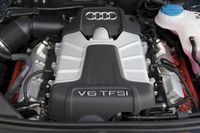Audi's New 3.0 TFSI Engine: Hi-tech V6 with Supercharging
SYDNEY, Australia – February 24, 2009: Powerful, spontaneous and ultra-efficient: this is the new top variant in Audi's V6 engine range. The 3.0 TFSI develops 213 kW and a huge 420 Nm of torque. It combines two state-of-the-art technologies – petrol direct injection and supercharging.
Audi has a long tradition of supercharged engines. The legendary Grand Prix racing cars built by Auto Union back in the 1930s already featured compressors, which coaxed as much as 440 kW out of the mighty 16-cylinder and 12-cylinder engines. From the late 1970s, attention was focused on the exhaust turbocharger, which helped Audi to a succession of noteworthy motor sport triumphs. It was at this time that Audi's turbo engines began to enjoy resounding market success.
The supercharger is now staging a comeback and is the ideal technology for the new three-litre V6, the 3.0 TFSI.
Extensive comparative tests revealed the mechanical supercharger to be superior to a bi-turbo concept for this engine. In conjunction with direct injection, its packaging, starting performance and dynamic response were far superior.
The supercharger is so compact that it easily fits inside the 90-degree V of the cylinder banks, in place of the intake manifold. Because it is driven by the engine via poly-V belt, its full thrust is available from idle speed upwards, producing huge pulling power when accelerating. The 3.0 TFSI delivers its maximum 420 Nm torque at just 2,500 rpm and maintains this constantly until 4,850 rpm.
The gas paths after the supercharger are very short; this means that the torque is built up extremely quickly, even more than on a naturally aspirated engine of the same displacement. The 3.0 TFSI responds to acceleration as it revs to a maximum of 6,500 rpm with ease, achieving its rated output of 213 kW at just under 5,000 rpm.
Top marks for fuel efficiency
In a comparison with the
previous 3.2 FSI and 4.2 FSI V8 engines it replaces, the 3.0 TFSI earns top
marks for fuel efficiency. Whilst the 3.2 FSI and 4.2 FSI V8 delivered
combined fuel consumptions of 10.9 litres and 11.0 litres / 100km
respectively, the 3.0 TFSI achieves an average of just 9.5 litres / 100km.
CO2 emissions are also down from 265 g/km and 262 g/km, to just 210 g/km.
The new 3.0 TFSI is designed to comply with Euro 5 emission standards.
Audi’s direct injection FSI principle has made this leading fuel efficiency possible. Unlike conventional concepts, it allows the supercharger to be located behind the throttle valve. Because of the low density of the intake air at loads below supercharging level and when coasting, its rotors are free-running and the amount of power required to drive them is low.
The engine's high compression ratio of 10.5:1 also plays a big part in its efficiency. The direct injection principle is once again the key, because the intensively swirled fuel cools the combustion chamber, reducing the tendency to knock.
The compressor of the new 3.0 TFSI is what is known as a Roots blower. Inside it, two four-vane rotary pistons counter-rotate at a speed of up to 23,000 rpm, with an air gap between them measuring just a few thousandths of a millimetre. The rotors can deliver 1,000 kilograms of air per hour and force it into the combustion chambers at a boost pressure of up to 0.8 bar.
Two water-to-air intercoolers made from aluminium and connected to a separate coolant circuit are integrated into the housing. Here, the compressed and therefore heated intake air is cooled again in order to boost its oxygen content for the combustion process. It’s also extremely quiet.
The engine itself belongs to Audi's family of ultramodern V engines. In addition to the standard cylinder angle of 90 degrees, attributes include systematic lightweight construction – the three-litre version's crankcase, which is made from cast aluminium/silicon, tips the scales at just 33 kilograms. The entire engine, including the supercharger, weighs 189 kilograms. The bore measures 84.5 millimetres and the stroke 89.0 millimetres, producing a swept volume of 2,995 cm3.
Reinforcements on the crankcase
Audi has included a whole
array of refined hi-tech features on the 3.0 TFSI. The crankcase has been
adapted to the higher prevailing pressures and all components are
frictionally-optimised. The two intake camshafts can be adjusted through 42
degrees crankshaft angle. In the intake ports, tumble flaps induce movement
in the incoming air to promote optimum mixture preparation.
The injection system is a fundamentally new design. A common rail system with six-hole injectors injects the fuel directly into the combustion chambers at a pressure of up to 150 bar. The injectors' highly dynamic response allows up to three fuel injections per operating cycle across an extensive range of the characteristic map. They, too, optimise the combustion process and therefore contribute to the impressive performance of the new 3.0 TFSI.



